Variables that represent the size can be added to a bubble chart for comparison to show the relationships among multiple variables. At most six variables can be added to a bubble chart. This topic describes how to add data to a bubble chart and how to configure the style of a bubble chart. Bubble charts are available only in group workspaces of the Quick BI Enterprise Standard edition.
Prerequisites
A dashboard is created. For more information, see Create a dashboard.
Overview
Scenarios
Two sets of data are used to generate multiple points in the coordinate system. You can observe the distribution of these points to determine whether a correlation exists between variables or summarize the distribution pattern.
Purpose: You can use a bubble chart to easily obtain the following key information:
Whether a quantitative correlation exists between variables.
Whether the correlation is linear or curved.
Whether outliers exist. An outlier indicates a point that deviates from most points. You can further analyze these outliers to determine whether they have a significant impact on the population during modeling analysis.
Benefits
Computing capability: The conversion rate is automatically computed.
Data visualization: A bubble chart can be dynamically displayed based on the timeline of data.
Example
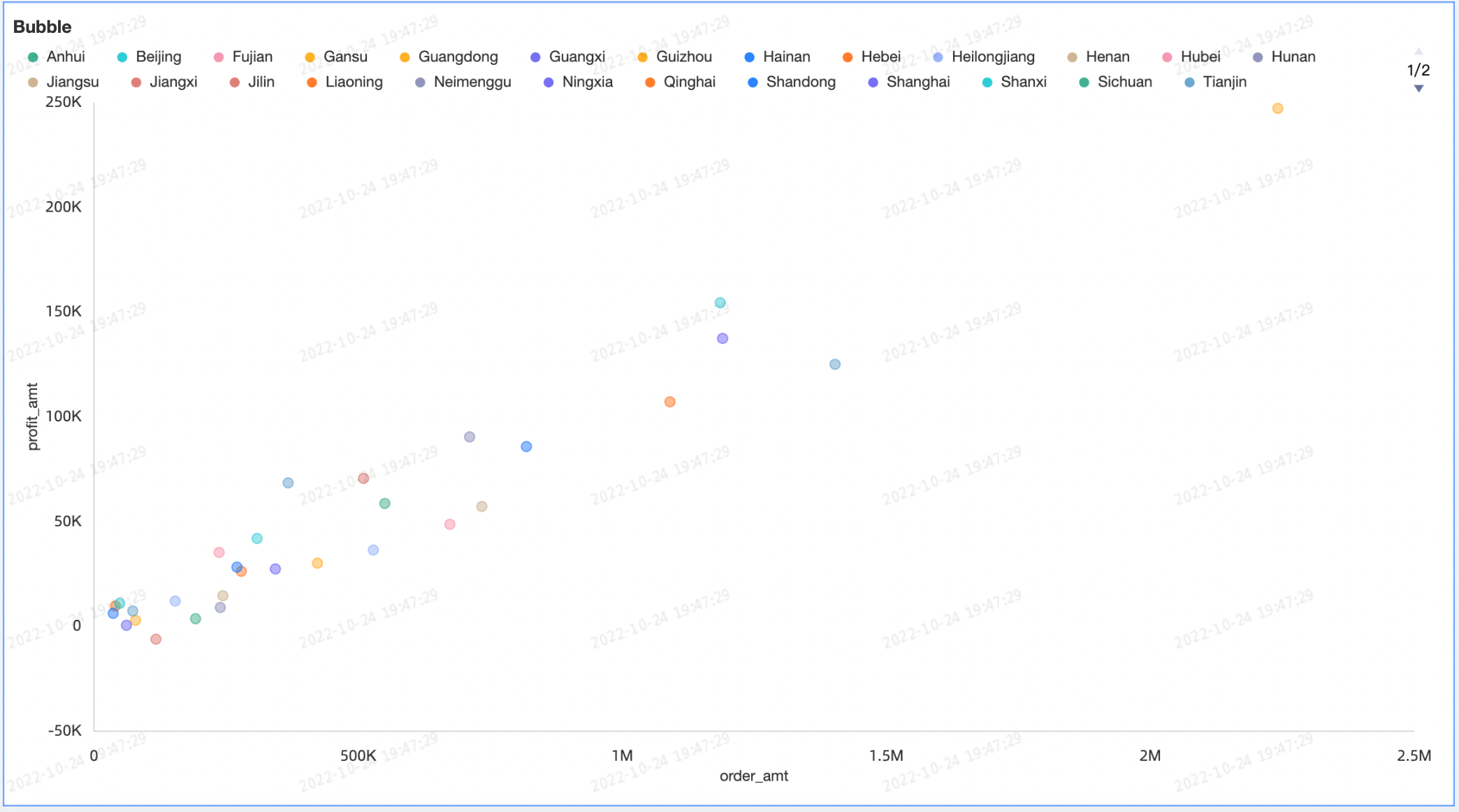
Configure a bubble chart
On the Data tab, select dimensions and measures based on your business requirements.
In the measure list, double-click order_number. You can also drag this measure to the Y axis (Mea.) field.
In the measure list, double-click price. You can also drag this measure to the X axis (Dim. or Mea.) and Size (Mea.) fields.
In the Dimension list, double-click product_type. You can also drag this dimension to the Category (Dim.) field.
In the Dimension list, double-click area. You can also drag this dimension to the Color (Dim. or Mea.) field.
In the Dimension list, double-click order_date(year). You can also drag this dimension to the Playback Timeline/Time Dimension field.
Click Update to update the bubble chart.

Auto Refresh
After you select Auto Refresh, the system refreshes the bubble chart as scheduled. For example, if you select Auto Refresh, enter 5, and then select Minutes, the system refreshes the bubble chart every 5 minutes.
Configure the style of a bubble chart
In the Basic Information section, set the following parameters:
1. Show Title and Description and custom header style
2. Show Link
3. Description
4. Footer
⑤ Component container
⑥ Card spacing

In the Chart Style section, set the Show Chart Labels, Show Legend, Color, and Bubble Size parameters.
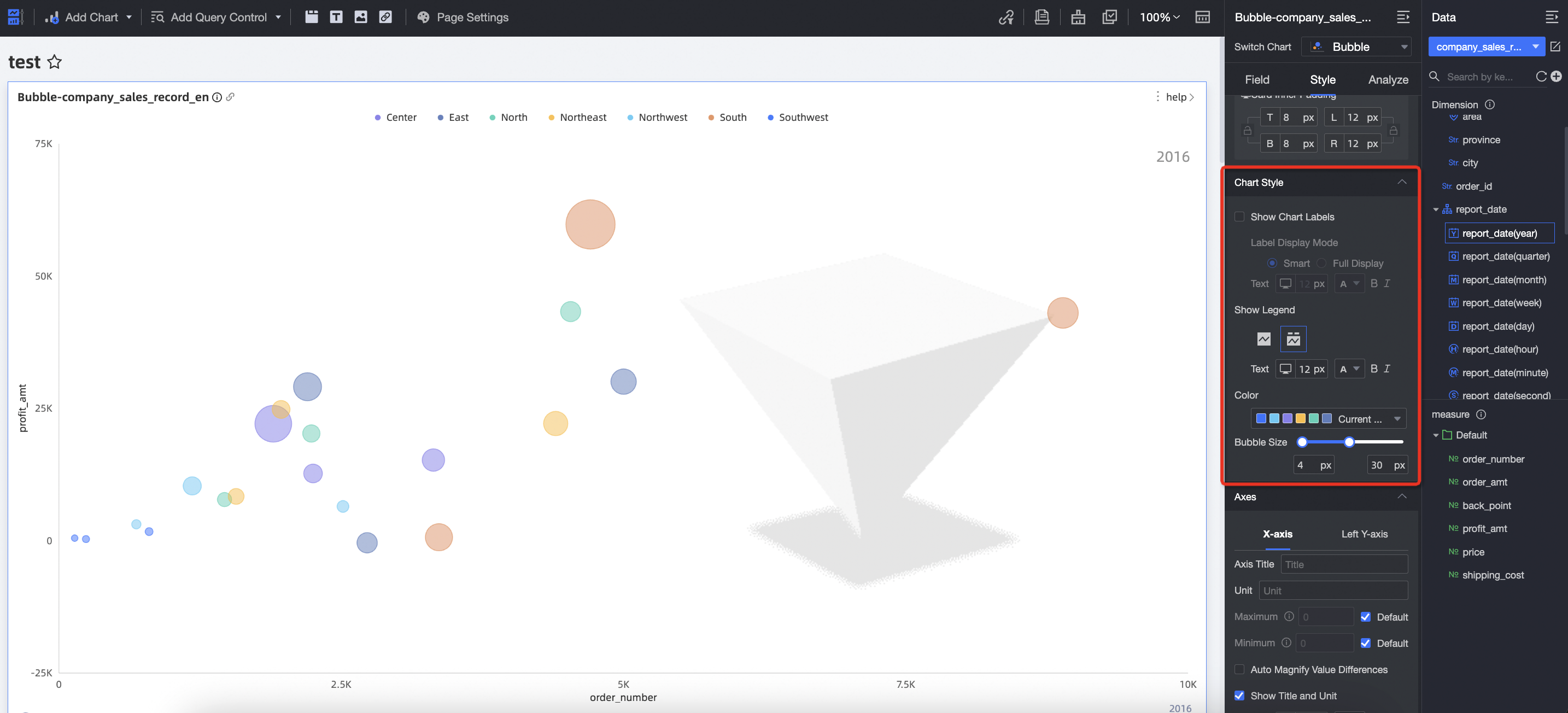
The Color parameter is displayed only when Color (Dim. or Mea.) is specified on the Data tab.
If you specify a dimension for Color (Dim. or Mea.), you can select a color series or set colors for different field values.
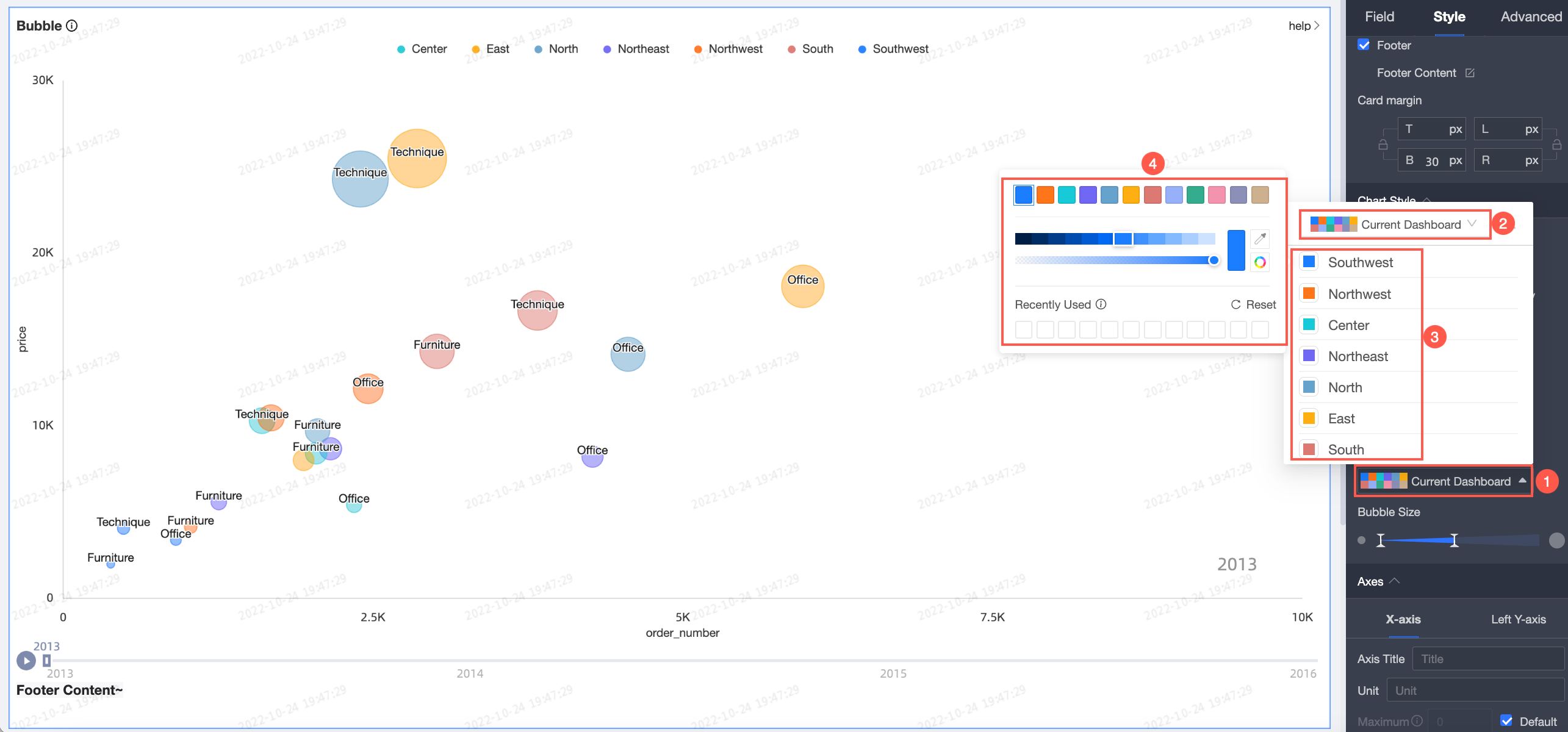
If you specify a measure for Color (Dim. or Mea.), you must configure the Data Mapping Segments parameter before you set color for different segments.
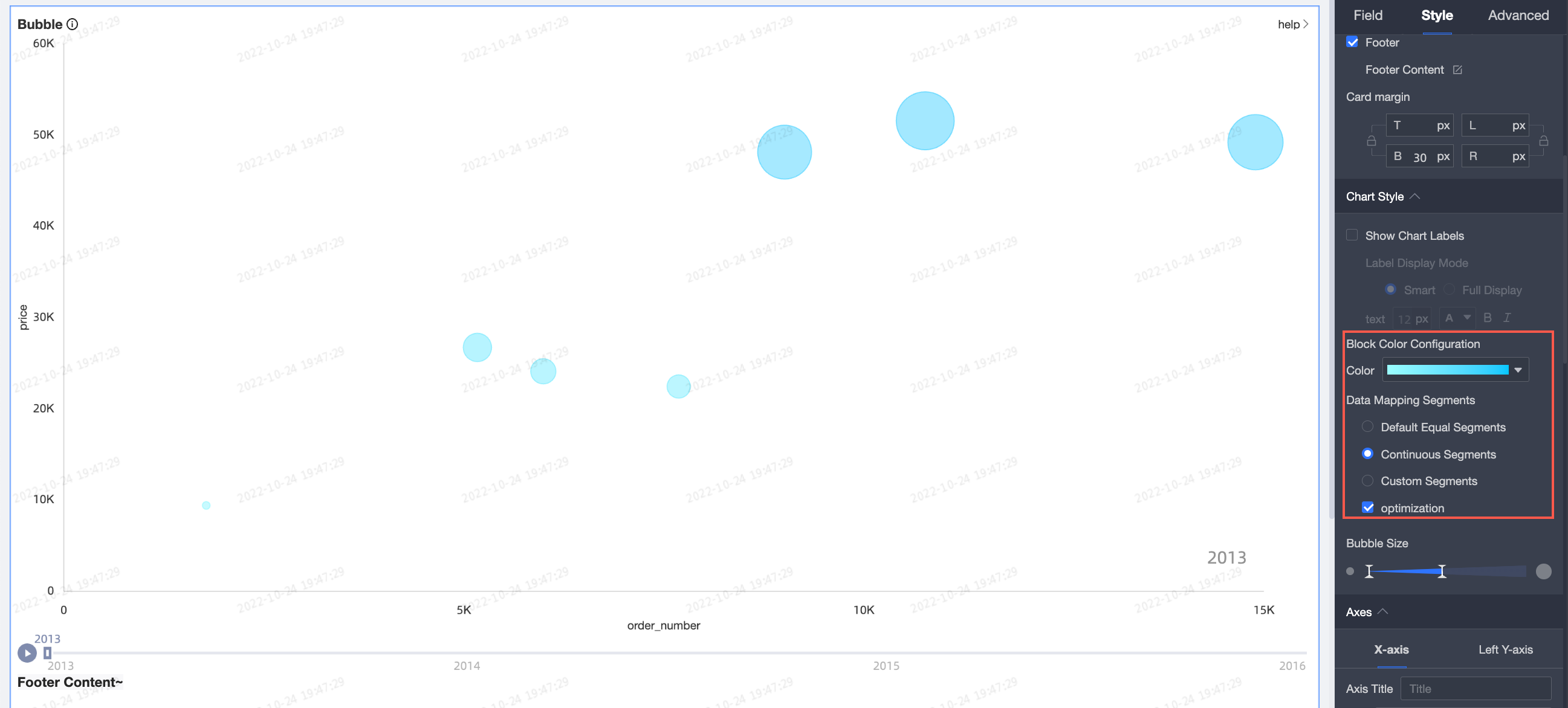
In the Axes section, configure the style of the axes. The following table describes the parameters.
Parameter
Parameter
Description
X-axis
Axis Title
The title for the x-axis.
Unit
The unit for the x-axis.
Show Title and Unit
Specifies whether to show the title and unit of the x-axis.
Show Axis
Specifies whether to show the x-axis. If you select Show Axis, you can specify the line style, line width, and color of the x-axis.
Show Value
Specifies whether to show values on the x-axis. If you select Show Value, you can specify the font type, font size, and color of values.
Gridlines
Specifies whether to show gridlines on the x-axis. If you select Gridlines, you can specify the line style, line width, and color of gridlines.
Show Scale
Specifies whether to show scales on the x-axis.
Left Y-axis
Axis Title
The title for the left y-axis.
Unit
The unit for the left y-axis
Minimum and Maximum
The minimum and maximum values on the left y-axis.
NoteIf you select Default, the minimum and maximum values are automatically displayed on the left y-axis. If you clear Default, you need to manually configure the minimum and maximum values on the left y-axis.
Auto Magnify Value Differences
Specifies whether to magnify the value differences on the left y-axis.
NoteIf Auto Magnify Value Differences is selected, the axis range is adjusted based on the minimum and maximum values of the displayed data.
Show Title and Unit
Specifies whether to show the title and unit of the left y-axis.
Show Axis
Specifies whether to show the left y-axis. If you select Show Axis, you can specify the line style, line width, and color of the left y-axis.
Y-axis Label Settings
The display formats for labels on the left y-axis. Valid values: AutoFit, Customer, and Manual.
NoteYou can also configure multiple measure display formats at a time on the Data tab. For more information, see Configure a chart.
Show Value
Specifies whether to show values on the left y-axis. If you select Show Value, you can specify the font type, font size and color of values.
Gridlines
Specifies whether to show gridlines on the left y-axis. If you select Gridlines, you can specify the line style, line width, and color of gridlines.
Show Scale
Specifies whether to show scales on the left y-axis.
Label and Scale Range
You can set the Maximum /Minimum value of the left Y-axis label and scale range based on Automatic or Manual Settings.
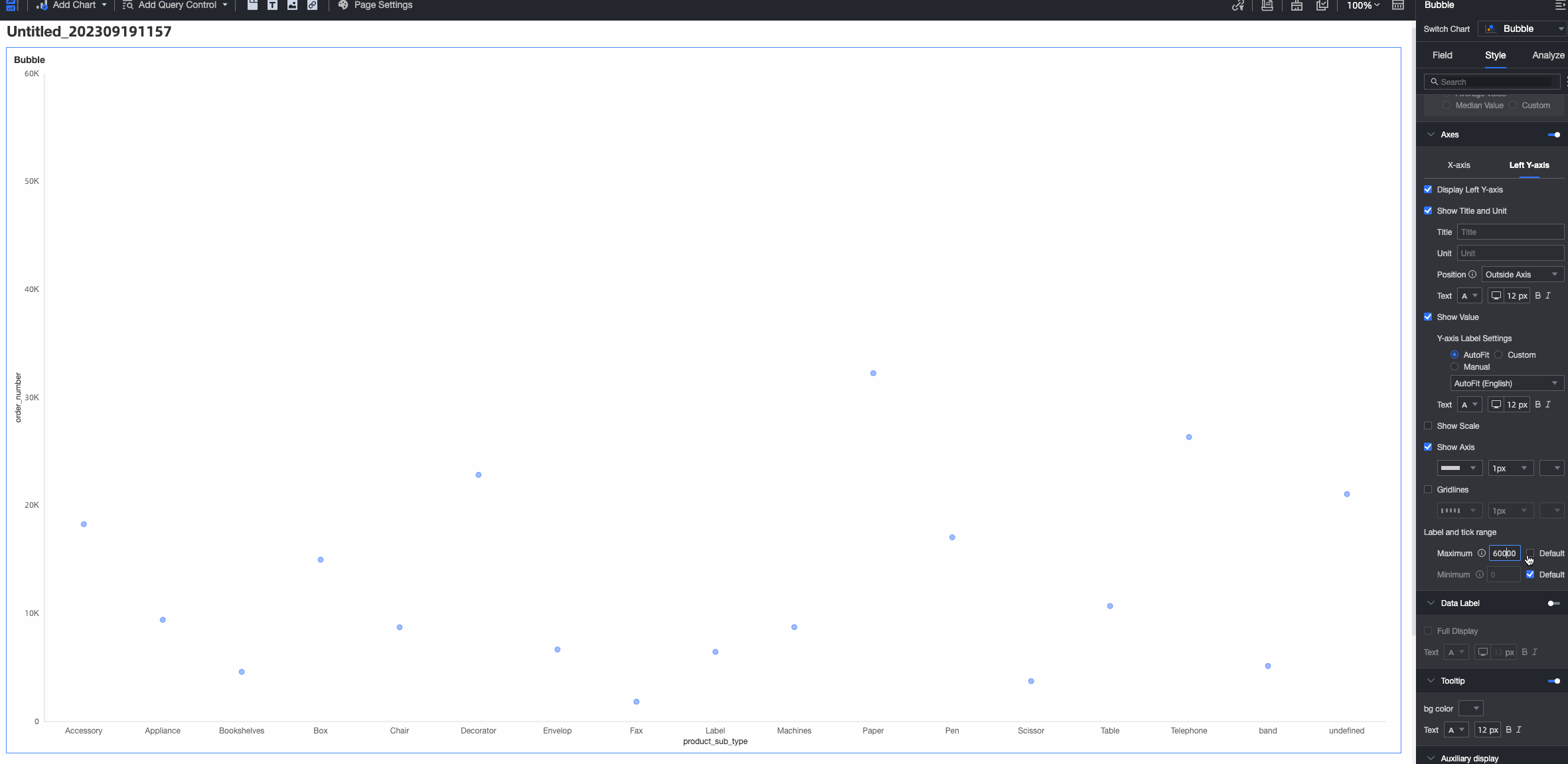 Note
NoteIf you select Dual Y-Axis in the Chart Style section, you also need to configure the Right Y-axis. The parameter configurations on the Right Y-axis are the same as those on the Left Y-axis tab.
In the Functionality section, select Enable Four-quadrant and set the displayed parameters.
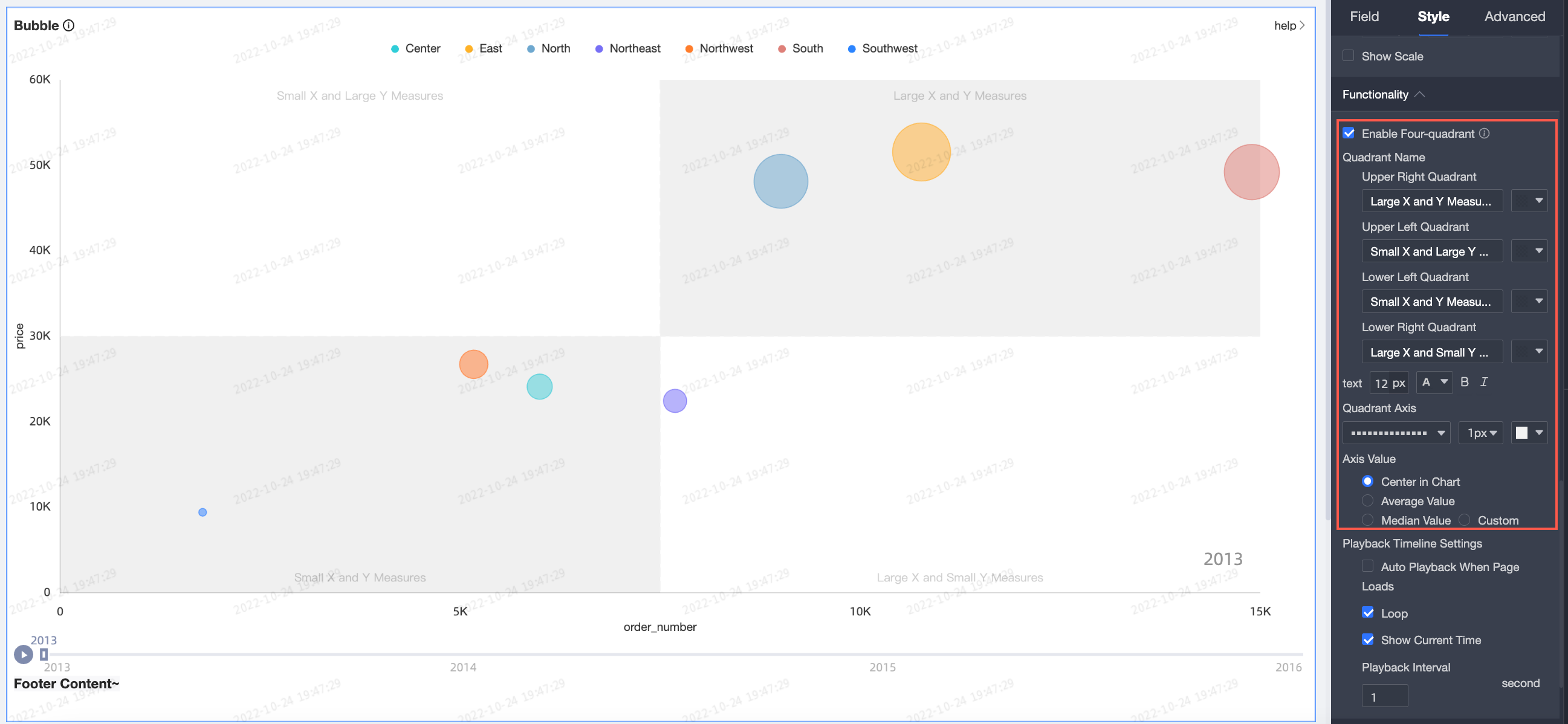 Note
NoteYou can enable the four-quadrant feature only when both Y axis (Mea.) and X axis (Dim. or Mea.) are specified with measures.
When you configure Playback Timeline Settings, take note of the following items:
If you select Auto Playback When Page Loads, the animation of the bubble chart is automatically played after the page is loaded.
If you select Loop, the animation of the bubble chart is played repeatedly.
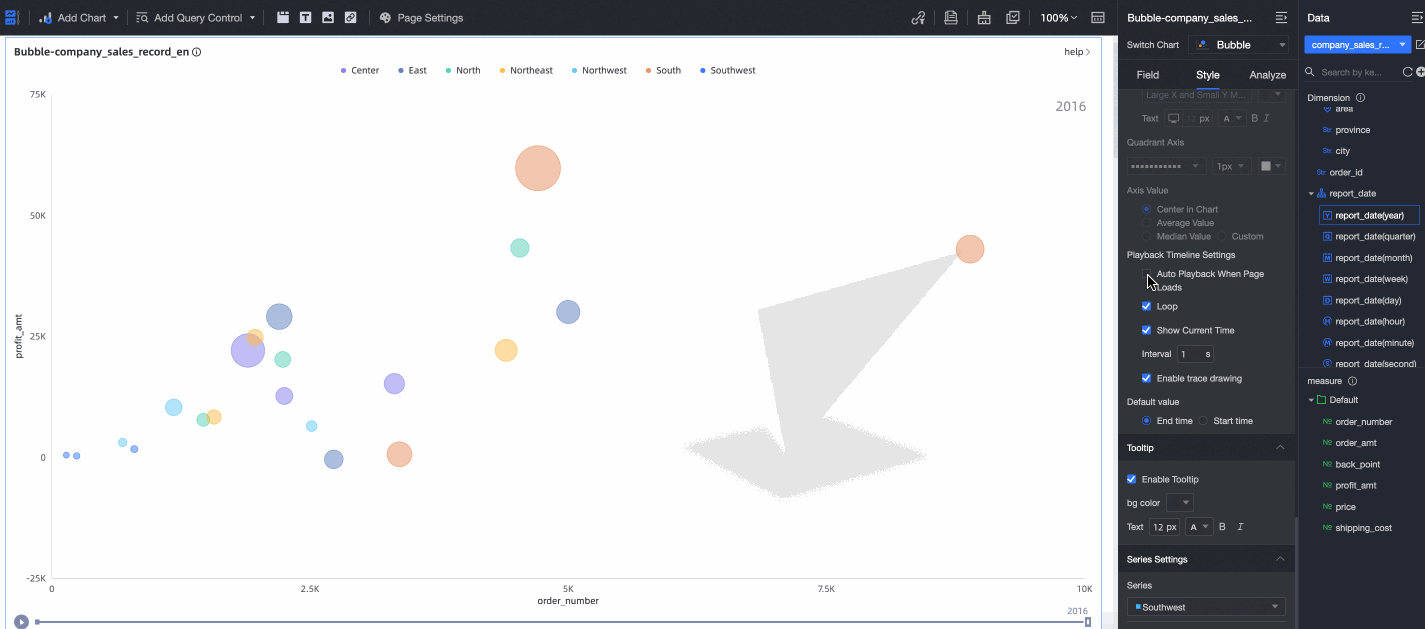
If you select Show Current Time, time is displayed during the playback.
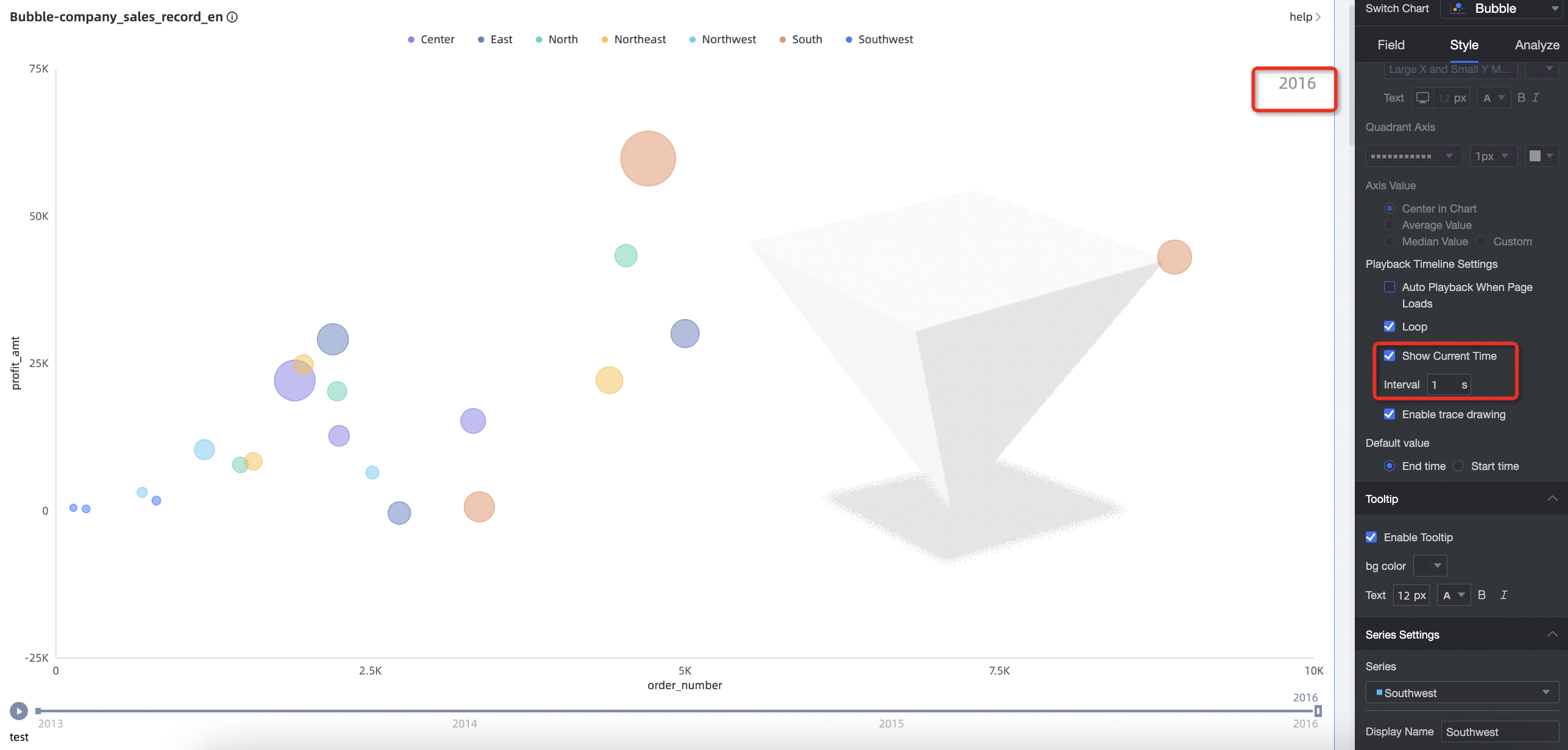
If you select Enable Trace Drawing, you can click a bubble to draw its trace in the order of the playback axis.

In the Series Settings section, configure Series and Display Name.
Configure advanced settings
Parameter | Field | Description |
Advanced Settings | Linkage | If the data that you want to analyze exists in different charts, you can click the Edit icon next to Linkage and set the parameters in the Filter Interaction dialog box. Charts can be associated for data analysis. For more information, see Drilling, filter interaction, and hyperlink. |
Hyperlink | If the data that you want to analyze exists in different dashboards, you can click the Edit icon next to Hyperlink and set the parameters in the Hyperlink dialog box. Dashboards can be associated for data analysis. For more information, see Drilling, filter interaction, and hyperlink. | |
Metric Analysis | Gridlines | A gridline is an auxiliary line that can be used to show the difference between the value of a measure and the reference value. The reference value is indicated by the auxiliary line. The reference value indicated by a gridline can be a fixed value or a calculated value. You can use the following calculated values: average, maximum, minimum, and median. For more information, see Metric analysis. |
Trendline | A trendline displays the overall trend of the data that you selected. Quick BI provides the following types of trendlines: Intelligent, Linear, Logarithmic, Exponential, Polynomial, and Power. For more information, see Metric analysis. Note Trendlines are supported only when the playback timeline is not used. | |
Error Check | You can use this feature to detect data anomalies. For more information, see Metric analysis. Note The Error Check feature is in public preview. | |
Clustering | After this feature is enabled, the value of the Color field changes to Clustering, and data points with similar x values and y values are displayed in a cluster. Note The Clustering feature is in public preview. | |
Label | - | If data in a chart is abnormal or requires extra attention, you can use background colors, icons, comments, or data points to mark the data. For more information, see Label. Note Labels are supported only when the playback timeline is not used. |
Limits
When you create a bubble chart, you must specify Y axis (Mea.), X axis (Dim. or Mea.), Category (Dim.), Color (Dim. or Mea.), Size (Mea.), and Playback Timeline/Time Dimension.
You can specify only one measure for Y axis (Mea.).
You can specify only one measure or one dimension for X axis (Dim. or Mea.).
You can specify only one dimension for Category (Dim.).
You can specify only one measure or one dimension for Color (Dim. or Mea.). The dimension or measure that you specified for Color (Dim. or Mea.) can be the same dimension or measure that you specified for X axis (Dim. or Mea.), Y axis (Mea.), and Category (Dim.).
You can specify only one measure for Size (Mea.). The measure that you specified for Size (Mea.) can be the same measure that you specified for Y axis (Mea.).
If you specify a measure for X axis (Dim. or Mea.), you can also specify this measure for Size (Mea.)
You can specify only one dimension for Playback Timeline/Time Dimension. The dimension must be a time field.
NotePlayback Timeline/Time Dimension is applicable only when you specify measures for both Y axis (Mea.) and X axis (Dim. or Mea.).
What to do next
You can share the dashboards that you created. For more information, see Share a dashboard.
If you want to create a navigation menu for thematic analysis, you can integrate a dashboard into the business intelligence (BI) portal. For more information, see Create a BI portal.